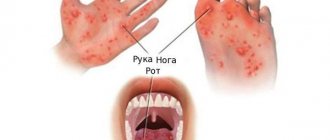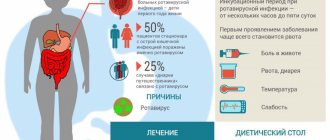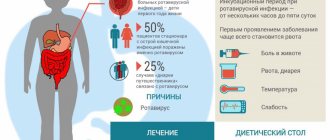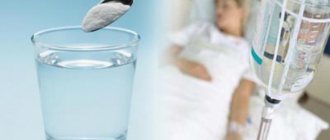The article was prepared by a specialist for informational purposes only. We urge you not to self-medicate. When the first symptoms appear, consult a doctor.
Nausea, vomiting with diarrhea and increased body temperature in a person most often suggest that he has food poisoning. In fact, the causes of this condition can also be reduced to an intestinal infection (damage to the body by viral or bacterial flora) or to diseases of the gastrointestinal tract.
Food poisoning as a cause of nausea, diarrhea, vomiting and fever
Food poisoning develops in humans when foods that contain toxins enter the body. They are produced by pathogenic flora that have colonized this very food product.
The first signs of poisoning appear just a few hours after eating a dangerous dish.
Its main symptoms will be as follows:
- Nausea.
- Vomit.
- Diarrhea.
- Abdominal pain like cramps.
- Increase in body temperature to 37-40 °C.
- Weakness.
- Paleness of the skin.
First, the person begins to feel sick, after which he begins to vomit. It is aimed at cleansing the stomach. There is no need to stop vomiting. However, if the attack is prolonged and indomitable, then you need to seek medical help. Such vomiting is a reason for prescribing antiemetic drugs.
When the vomiting stops, the person should feel better. At the same time, weakness will increase and the skin will become pale. During this period, you need to start taking sorbent drugs, for example, Activated carbon, Enterosgel. A weak solution of potassium permanganate can be used to lavage the stomach. In small doses, it is possible to use infusions of medicinal herbs (St. John's wort or chamomile).
Diarrhea, like vomiting, is aimed at cleansing the body of toxins. It allows you to remove harmful substances from it. In this case, the feces will change their usual color.
When a person develops diarrhea, they will feel cramping along the bowels. Sometimes they persist for some time after the diarrhea ends. Diarrhea leads to dehydration of the body, so patients are advised to take Regidron.
The higher the body temperature, the more severe the food poisoning. If it does not exceed subfebrile levels, then the poisoning is minor. When the body temperature reaches 38 °C, you need to seek medical help, as this indicates an acute toxic infection.
Mild and moderate food poisoning does not require hospitalization. To reduce body temperature, you need to take antipyretic drugs, and to destroy toxins in the intestines, nitrofurans.
If a person’s health worsens, he develops a fever, headaches, heart rate suffers, or vision problems arise, he must be urgently hospitalized.
Children suffer from poisoning more severely than adults, since the child’s immunity is not yet strong enough. A foodborne illness that would only cause stool liquefaction in an adult can be accompanied by severe diarrhea and vomiting in a child.
If a child has signs of food poisoning and the body temperature rises, it is necessary to call a medical team. This condition is a reason for emergency hospitalization. Alternatively, you can do an enema with salted water. Why do you dissolve a tablespoon of salt in a liter of water?
Intestinal infection as a cause of nausea, diarrhea, vomiting and fever
Vomiting, diarrhea and high fever are often symptoms of an intestinal infection. It can be caused by bacterial or viral flora. The disease is difficult to tolerate, so you need to start treatment as early as possible. To determine which infectious agent has affected the intestines, it is necessary to take a test of stool, urine and blood. Sometimes vomit is collected. Depending on the type of pathogen, the doctor will prescribe appropriate treatment.
Most often, intestinal infection develops in the following cases:
- Rotavirus infection.
- Infection with bacteria of the genus Shigella.
- Salmonella infection.
In addition, high body temperature with diarrhea and vomiting may indicate viral hepatitis.
Rotavirus infection
Rotavirus infection is called intestinal flu. The disease develops when microorganisms from the rotavirus family enter the human body, but they have nothing to do with influenza viruses. The disease was named so because of the similarity of the main symptoms. With rotavirus infection, a person experiences vomiting, high body temperature, headaches, diarrhea, cough, sore throat, runny nose, and increased weakness. The route of infection is fecal-oral.
The consistency of feces begins to resemble clay. They change their natural color to grayish-yellow. Blood streaks may be found in the stool. Children suffer from rotavirus infection more often than adults. They bear it harder. As a rule, the pathology is accompanied by vomiting and diarrhea. Against the background of high body temperature, this threatens dehydration. In this case, you should immediately seek medical help. The first rotavirus infection is especially acute. After this, the body produces antibodies that form further immunity. This does not mean that infection will never happen again, but next time the infection will be easier to bear.
There is no drug that specifically destroys rotaviruses. Parents will need to focus their efforts on combating the main symptoms of the disease. It is important to give the child something to drink and give him enterosorbents as prescribed by the doctor.
It must be remembered that rotavirus infection is contagious, so you need to be careful when contacting the patient.
Dysentery
Dysentery is caused by bacteria from the genus Shigella. They penetrate the large intestine and damage it. You can become infected with dysentery by drinking contaminated water and food, as well as from a sick person. The first symptoms of dysentery will appear 2-7 days after contact.
A person experiences headaches, lethargy increases, body temperature rises, and abdominal cramps appear. After a short time, diarrhea develops, the temperature reaches 39 °C, the skin becomes pale, the tongue becomes dark. The heart begins to beat faster, blood pressure drops.
A person has 20-50 bowel movements per day. As the disease progresses, it will consist of mucus, pus and blood. Dysentery lasts 3-4 weeks. The disease is dangerous due to the development of peritonitis and paraproctitis.
If the infection is uncomplicated, the patient is transferred to treatment table No. 4 and given nitrofurans and hydroxyquinolines. When the disease is severe, several antibacterial drugs are required.
Salmonellosis
Salmonellosis is caused by bacteria of the genus Salmonella. Infection occurs by eating contaminated foods or by contact with a sick person or animal.
The disease has an acute onset; the infected person’s body temperature rises sharply and chills occur. The patient feels very sick and vomits, and has a headache.
The stool becomes watery, which happens very often. The stool becomes green and bile is visible in it. Similar symptoms persist for 8-10 days. In addition, the patient complains of aching joints. Upon palpation, the doctor notices an increase in the size of the spleen and liver.
A patient with salmonellosis is hospitalized in a separate ward. An accurate diagnosis can be made through laboratory tests. Therapy comes down to taking penicillin, fluoroquinolones, and bacteriophages. If there is no blood in the stool, then you can do without prescribing antibacterial drugs.
The patient is advised to drink plenty of fluids throughout the recovery period to prevent dehydration. At the same time, he must take enterosorbents and prebiotics.
Complications of the disease include:
- Toxic shock.
- Inflammation of the peritoneum.
- Polyarthritis.
- Kidney failure.
Viral hepatitis
Hepatitis is accompanied by liver damage. The first symptoms of the disease may appear 7 days to 6 months after the infection enters the human body. The clinical picture depends on which virus led to the infection (A, B, C, D, E, F, G). Infection occurs through drinking contaminated water, eating contaminated food, using shared syringes, or unprotected sexual contact.
First, a person’s body temperature rises and pain appears in the upper abdomen. Then the joints begin to ache, the head hurts, and the appetite disappears. The next symptom of hepatitis is diarrhea with severe bloating. The skin begins to itch.
The liver and spleen increase in size, urine becomes dark and feces light, the skin and eye sclera turn yellow. At the same moment, the patient’s well-being improves slightly.
Depending on a person’s immunity, the disease can be either mild or severe.
There is no treatment for hepatitis A. The person is hospitalized and prescribed plenty of fluids and bed rest. To reduce pain, taking antispasmodics is indicated. If the intoxication of the body is severe, then the patient is prescribed choleretic drugs, and detoxification solutions are administered intravenously.
Other types of hepatitis virus lead to serious consequences. Patients will require administration of interferons and antiviral drugs. Correct and timely treatment leads to stable remission. The patient is prohibited from drinking alcoholic beverages for a long time.
Complications of hepatitis:
- Cirrhosis of the liver.
- Necrosis of organ tissue.
- Liver cancer.
- Chronic gallbladder diseases.
Complications after ARVI in children
Complications after acute respiratory viral infections in children are directly related to the type of viruses that affected the body. The addition of a bacterial infection often leads to bronchitis, the lungs are also affected, and pneumonia may develop. According to statistics, with enterovirus infections, bacteremia complicates the course of ARVI in almost 7% of cases.
Young children are at risk of developing acute otitis, including purulent otitis, which requires antibiotic therapy. If a child’s nose is stuffy for more than two weeks, and there is a worsening of the condition after the first week and pain in the face, this may indicate the development of bacterial sinusitis.
ARI can also become a trigger for exacerbation of existing chronic diseases in a child, most often bronchial asthma and urinary tract diseases.
Complications of ARVI in children: can they be avoided?
It is not only impossible to protect children from ARVI, but in the opinion of many pediatricians, it is not necessary. According to experts in the field of child health, acute respiratory viral infections form the child’s immunity and “train” his immunity to identical and more severe viral infections that may occur in the future.
In case of ARVI with abdominal syndrome in children, you must immediately consult a doctor who will prescribe diagnostic measures and, depending on the identified cause of the disease, recommend treatment.
Treatment for ARVI should be started at the first symptoms of the disease and include methods to reduce intoxication of the body (for example, you must remember to give the child clean, warm water without sugar more often), as well as taking medications and carrying out symptomatic treatment. When fighting viruses, it is better not to try to fight the disease only by drinking plenty of fluids and rest, but to immediately give the child an antiviral drug.
One of the antiviral drugs approved for the treatment of children from the first days of life is the drug VIFERON, which has a wide spectrum of antiviral activity. Antiviral properties allow it to block the reproduction of the virus, and the immunomodulatory effect helps restore immunity. The drug, which is produced in the form of suppositories, gel and ointment, was developed as a result of fundamental research in the field of immunology, which proved that in the presence of antioxidants (vitamins C, E), the antiviral effect of interferon is enhanced.
The drug VIFERON Suppositories can be used to treat very young children, including newborns and premature babies with a gestational age of less than 34 weeks.
VIFERON Gel can be used for the treatment and prevention of ARVI and influenza, starting from the first days of a child’s life. VIFERON Ointment is used to treat children from 1 year of age.
Diseases of the gastrointestinal tract, as a cause of nausea, diarrhea, vomiting and fever
Most diseases of the digestive system are manifested by nausea, pain, vomiting, and loose stools. The most common pathologies include pancreatitis, gastritis, ulcers, and gastroduodenitis.
Pancreatitis is inflammation of the pancreas. It can begin against the background of alcohol abuse, with serious errors in nutrition. Such causes of pancreatitis are more typical for males. In women, the inflammatory process occurs mainly during dieting, as well as against the background of hormonal imbalance in the body.
The first sign of pancreatitis is vomiting. It will contain bile. In addition, the person will begin to suffer from severe pain in the upper abdomen. Then diarrhea occurs, and body temperature may rise. If the disease has a mild or moderate course, then outpatient treatment is possible. When the body temperature rises to 38 °C or higher, hospitalization of the patient is required.
Any disease of the digestive system can pose a serious threat to human life and health, therefore, when the first signs of a disorder appear, it is necessary to seek medical help.
Dangerous symptoms
You can identify the most dangerous symptoms of health problems that require immediate consultation with a doctor.
These include:
- Sudden onset of nausea, which is accompanied by bloating, diarrhea, weakness and an increase in body temperature to 37.5 °C. These symptoms may indicate food poisoning. To improve your health, you need to induce vomiting, rinse the stomach, and also seek medical help. If you managed to cope with the disorder on your own, then after cleansing the stomach you need to take several tablets of Activated Carbon (1 tablet per 10 kg of person’s weight).
- Increasing body temperature, diarrhea with blood and mucus, vomiting, weakness. Such symptoms may indicate an intestinal infection. If the stool becomes light, the urine becomes dark, and the skin becomes yellowish, hepatitis may be suspected. Without the help of a doctor, it will not be possible to cope with the problem.
- The appearance of light-colored stool, nausea with a sour taste, vomiting with bitterness in the mouth, high body temperature. These symptoms may indicate developing pancreatitis. Stomach ulcers and inflammation of the gallbladder exhibit similar symptoms. Such pathologies require emergency medical care, as they pose a direct threat to human life and health.
Diarrhea, nausea and vomiting accompany many diseases of the gastrointestinal tract. Sometimes they occur with elevated body temperature, and sometimes it remains within normal limits. If, during the period of exacerbation of the disease, a person was not provided with high-quality medical care, then the pathology can become chronic. It will be more difficult to cope with it. Therefore, even mild but frequent nausea and vomiting is a reason for a comprehensive examination.
Acute intestinal infections
Staphylococcus is a bacterial infection.
Acute intestinal infections, or acute intestinal infections, are a group of diseases caused by infectious agents. Types of OKI:
- Bacterial infections - salmonellosis, eschechiriosis, Pseudomonas aeruginosa, Proteus, staphylococcus, cholera, botulism
- Viral infections – rotavirus and others
- Fungal diseases - most often candidiasis
- Parasitic infections – Giardia, protozoa
Symptoms of OCI:
- Temperature rises to 37o C and above. Cholera does not cause fever
- Nausea
- Repeated, unrelieved vomiting
- Diarrhea
- Changes in stool - watery, discolored, blood and mucus
- Painful bowel movement
- Pain in the epigastric region
All these pathologies require hospital treatment. The exception is intestinal flu (rotavirus) in adults. Children with this diagnosis will have to undergo treatment in an infectious diseases hospital or a hospital department.
When should you see a doctor?
If diarrhea, vomiting, nausea and other health problems do not go away within 24 hours, then you should forget about self-treatment. This is especially true in a situation where a person’s body temperature rises and blood appears in the stool or vomit. In such a situation, you need to call an ambulance or go to the hospital yourself.
Emergency medical care is required in the following situations:
- Diarrhea and vomiting do not stop longer than 1-2 days.
- Body temperature rises to high levels.
- Blood and mucus are visible in the stool and vomit.
- The person is in severe pain.
- Symptoms of dehydration appear: the mouth becomes dry, you are constantly thirsty, weakness and dizziness increase.
- Vomiting and diarrhea develop in a child or in a pregnant woman.
- Several people in one family fell ill at once.
To establish a diagnosis, the doctor will prescribe the following tests to the patient:
- Donating blood and urine for general analysis.
- Analysis of feces for helminth eggs.
- BAK stool culture.
- Coprogram.
- Ionogram.
- Renal function tests.
Instrumental diagnostics comes down to the implementation of the following techniques: irrigoscopy, colonoscopy, sigmoidoscopy, ultrasound. Only based on the results of a comprehensive diagnosis will it be possible to detect the exact cause of the ailment and prescribe treatment.
Defecation disorder – constipation or diarrhea
If abdominal pain lasts more than 6 hours, this is a clear sign of an inflammatory process. Treatment is exclusively surgical in a hospital setting. The prognosis is favorable.
Rotavirus in children - causes, symptoms, treatment
Rotavirus enteritis is an acute viral disease.
Rotavirus enteritis is an acute viral disease. Transmitted by the fecal-oral, airborne route - this is a classic “dirty hands” disease. Rotavirus is dangerous for young children, since their immune system is not yet able to adequately respond to this type of virus. Symptoms of rotavirus infection:
- The first signs are a classic respiratory infection - runny nose, sore throat
- Increased body temperature that is not controlled by antipyretic drugs
- Uncontrollable debilitating vomiting and diarrhea. Stool up to 10 times a day
- Headache
- Lethargy
- Weakness and lethargy
Dehydration poses a particular danger. Due to constant vomiting, the baby is afraid to eat and drink. In severe cases, kidney failure and circulatory disorders may develop. The duration of the disease depends on the severity of the symptoms and lasts from 2 to 6 days. Treatment of rotavirus infection is carried out on an outpatient basis. In severe cases with severe dehydration, the child will have to be hospitalized in a hospital.
Important! There are no specific drugs to treat rotavirus. Treatment is symptomatic and boils down to rehydration of the body. Antiseptics or antibiotics are not allowed. It is important to follow the diet recommended by your doctor throughout treatment and during the recovery period. In general, the prognosis for this disease is favorable. Rotavirus does not cause complications and does not affect the child’s future life.
First aid for diarrhea, vomiting and fever
First aid to a patient is not aimed at completely ridding the person of the disease, but at making him feel better.
Recommendations for providing first aid to a patient with diarrhea, vomiting and nausea:
- Accept adsorbents. The most famous drug is activated carbon. For every 10 kg of weight you will need to take 1 tablet of the drug. Adsorbents are taken in a situation where a person has poisoning or an intestinal infection. After taking the drug, you need to make sure that the person has a bowel movement no later than 5 hours later. Otherwise, all harmful substances will be absorbed into the blood.
- Take an antispasmodic. These drugs allow you to relieve pain and spasms in the intestines, gall bladder, liver, etc. These medications include: No-shpa, Duspatalin, etc.
- Rinse the stomach. If a person knows for sure that he has been poisoned, then he needs to rinse his stomach. To do this, drink 8 glasses of a weak solution of potassium permanganate and induce vomiting. Repeat the procedure until only clean water begins to come out of the stomach, without pieces of food. If after gastric lavage it does not get better, then you need to consult a doctor.
There are some conditions for a speedy recovery, which include:
- You should not take any medicine to stop diarrhea unless prescribed by your doctor. The body fights intestinal infection on its own by removing pathogenic flora from the organ along with feces. If a person takes a drug to stop diarrhea, this process will stop. The bacteria will remain in the intestinal lumen and begin to absorb blood, and with its current spread throughout the body. This is the basis for the development of severe complications. You can take Activated Carbon or Smecta on your own.
- To speed up the process of removing harmful flora from the body, you can give an enema.
- Be sure to drink as much water as possible to prevent dehydration.
- Self-medication can be dangerous to health.
- A person with an intestinal disorder needs help and proper care.
- During illness, you need to stay in bed. If vomiting does not stop, then place a basin or other suitable container next to the bed.









